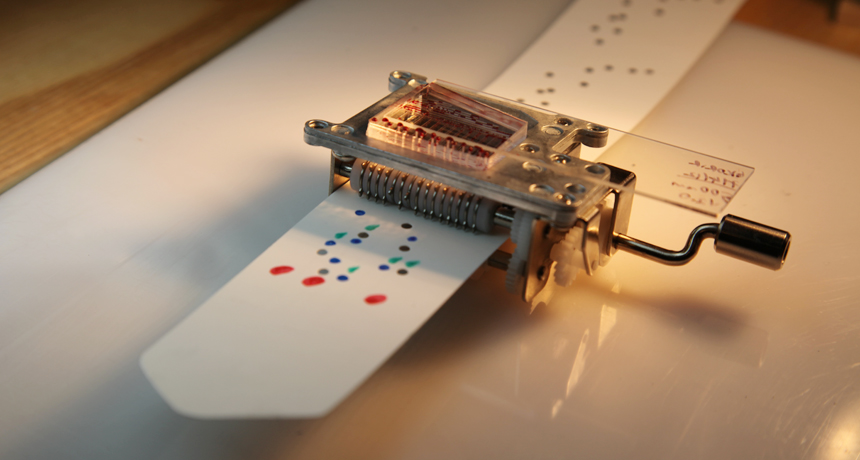A hand-held, crank operated chemistry set
SPARK competition winner brings tiny chemical reactions to your classroom, house or lab

This device cranks out chemistry in the palm of your hand. The inventor is the winner of the SPARK competition to find the chemistry kit of the future.
George Korir/Stanford Univ.
The next-generation chemistry set may look nothing like the one your parents used. It’s not a bunch of glassware or little bottles of chemicals. And hopefully there won’t be any explosions. Instead, it’s a small, hand-cranked machine that fits into the palm of your hand. It takes in bits of paper and serves as a platform for a safe, contained chemical reaction. This chemistry-kit-of-the-future should also be affordable; It may cost as little as $5 or $10.
The device, known as the “lab on a chip,” took top prize today in the first Science, Play and Research Kit Competition, or SPARK. Sponsored by the Gordon and Betty Moore Foundation and Society for Science & the Public (this blog’s parent organization), the contest aimed to find a chemistry kit that would let kids experiment without blowing up the garage.
The winning design was the brainchild of Manu Prakash. He and his graduate student, George Korir, are inventors at Stanford University. Their kit relies on microfluidics. This technology uses small plastic cards, each about 2.54 centimeters (1 inch), or the size of a postage stamp. The cards contain tiny pipes and pumps. Putting the chip in an actuator, a machine that supplies power to it, makes chemicals flow through its piping.
Scientists use microfluidics in their laboratories. But their commercial chips often need very expensive machines both to make the chemicals move and to read the results.
Prakash and Korir are working to change that. Their new chemistry set puts the tiny microfluidics chip up against paper cards that can be soaked in chemicals. Using a conventional paper punch, the user can punch holes in the chemical-soaked card to essentially tell the system what to do.
The inventors have developed a “language” of punched holes. If you punch the card using one of their preset patterns, it will direct a valve on the tiny hardware chip to open or shut. Put the microfluidics chip in the actuator, a hand held device that you operate by turning a crank. Then crank the card through. The hole-punched pattern in the paper will also release chemicals at the appropriate time onto chemicals already present in the chip. As the cranking pushes the paper forward, tubes in the microchip open and close to produce the desired chemical reaction.
Many of the punch-cards change color to show when a chemical reaction has taken place. Prakash says that you can also use the device with a microscope. That would permit the home chemist to see the chip in action, watching what changes over time.
The punch-card insert and the tiny chips make the device flexible. In the future, there could be books of punch-cards and chips for kids to get started doing chemistry.
From there, the sky’s the limit. You can soak laboratory filter paper in chemicals to make your own punch-cards, or refill the chips with chemicals that you would like to see react. “The way you should think of it,” Prakash says,” is just like a computer. A computer is a tool and you do whatever you want to do with it.”
Prakash and his laboratory will be using the $50,000 they have just won from the SPARK competition to build more copies of their “lab on a chip.” They want to publish an open-access paper on the invention, so anyone can read it without cost. That will allow scientists and others to build their own versions of the device.
Winning the SPARK competition means Prakash will be able to build more than one model of his invention, and apply for other funding to have people test and improve upon its design. Prakash hopes that microfluidics users will share patterns and perhaps upload them to a website where anyone can download the patterns and planned experiments for free.
Prakash says that this invention is an example of how he would like to get people into science. He says that he has become frustrated with all of the book learning required before students can do experiments for themselves. He says he wants to “flip that around and give kids problems they can solve. Once they discover something on their own, they are hooked.” With his new chemistry set, he hopes to pull kids in with chemistry they can do on their own. All it takes is his new device and a child’s imagination.
Power Words
chemical reaction A process that involves the rearrangement of the molecules or structure of a substance, as opposed to a change in physical form (as from a solid to a gas).
chemistry The field of science that deals with the composition, structure and properties of substances and how they interact with one another. Chemists use this knowledge to study unfamiliar substances, to reproduce large quantities of useful substances or to design and create new and useful substances.
microfluidics A field of science that brings together engineering, chemistry and physics. The goal is to use very small amounts of chemicals and bring them together in a tiny space to produce miniscule chemical interactions. The technique can be used in many fields of science.
Follow Eureka! Lab on Twitter: @eureka_labs